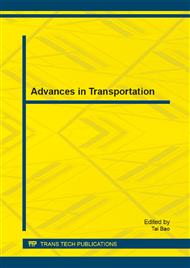[1]
O'Kelly, M. E. Eu-ropean Journal of Operational Research, (1987), 32: 393–404.
Google Scholar
[2]
Ebery, J. European Journal of Operational Research, (2001), 128 (2): 447–458.
Google Scholar
[3]
Ernst, A.T., Krishnamoorthy, M. Location Science, (1996), 4 (3): 139–154.
Google Scholar
[4]
Ernst, A.T., Krishnamoorthy, M. Informs Journal on Computing, (1998B), 10(2): 149–162.
Google Scholar
[5]
Campbell, J.F. Euro-pean Journal of Operational Research, (1994b), 72: 387–405.
Google Scholar
[6]
In Chinese: ShiweiHe, Theory and Methods of Comprehensive Traffic Hub Plan [M]. 1st ed. Beijing: China Communications Press, (2012): 86-88.
Google Scholar
[7]
Kara, B.Y., Tansel, B.C. Journal of the Operational Research Society, (2003), 54: 59–64.
Google Scholar
[8]
In Chinese: JieYu. Research on theory and method of urban public transport hub layout location [D]. Shanghai: Tongji University. (2007).
Google Scholar
[9]
Alumur& Kara. European Journal of Operational Research, (2008), 190: 1-21.
Google Scholar
[10]
Marín, A. Computers and Operations Research, (2005), 32: 3093–3109.
Google Scholar
[11]
Contreras, I., Cordeau, J. F., & Laporte, G. Operations Research, (2011c), 59(6): 1477–1490.
Google Scholar
[12]
O'Kelly, M. E. Journal of Geographical Systems, (2009), 11: 227–241.
Google Scholar
[13]
Ishfaq, R., & Sox, C. R. European Journal of Operational Research, (2011), 210: 213–230.
Google Scholar
[14]
Taghipourian et al. Applied Mathematical Modelling, (2012), 36(7): 3257-3270.
Google Scholar
[15]
Alumur, Nickel, et al. Transportation Research Part B, (2012), 46(4): 529–543.
Google Scholar
[16]
Karimi, Bashiri. Scientialranica, (2011), 18(6): 1571-1578.
Google Scholar
[17]
Alder, N., & Hashai, N. Transportation Re-search, (2005), 39: 878–894.
Google Scholar
[18]
In Chinese: XifengTang, HaijunMao. Journal of Southeast University(Natural Science Edition), (2009), 39(2): 404-407.
Google Scholar


